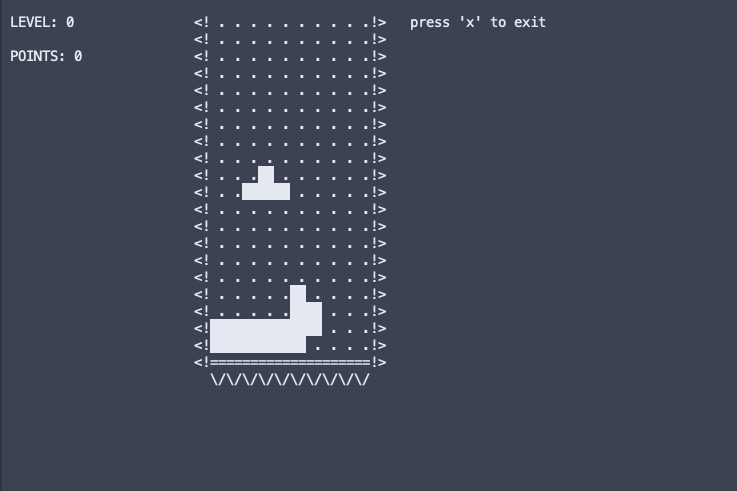Download with git clone https://github.com/GPotoshin/ascii_tetris.
Run make to compile that project.
You might need to download ncurses library on your machine.
Each figure is an array of four pointers to arrays of 8 numbers, which are allocated on stack.
typedef char figure[8];
const figure O[4] = {
{0, 0, 0, 1, 1, 0, 1, 1},
{0, 0, 0, 1, 1, 0, 1, 1},
{0, 0, 0, 1, 1, 0, 1, 1},
{0, 0, 0, 1, 1, 0, 1, 1}
};Those octates numbers are divided in pairs of relevant coordinates. Arrays are placed in order of rotation, so it can be easily done by adding or subtracting 1 in the ring of rests of 4.
The position is stored in global variable pos, rotation in rot, and figure *tetris is a pointer to the current figure displayed on the screen.
int main () {
if (init())
goto _bailout;
refresh();
getch(); // wait to start
mvprintw (1, 51, "press 'x' to exit ");
mvaddfig (pos.y, pos.x, tetris[rot], 'c');
// set game not to wait for input
nodelay (stdscr, TRUE);
while (!quite) {
run();
}
_bailout:
// set back to default settings
move (0, 0);
nodelay(stdscr, FALSE);
curs_set (1);
endwin();
system ("stty sane");
return 0;
}Despite that goto constructions are considered a bad habit, their main idea was not to use them instead of if, else, for and while etc. In C we do not have exceptions and goto can easily blend into code to satisfy that need.
char mod (char a, char b)Unfortunately % is not the same thing as taking rest of division
void mvaddfig (int y, int x, figure fig, char ch)I'm trying to keep the same style of naming functions as in ncurses library. It draws figure at a right spot
void removefig (int y, int x, figure fig)Removes figure while keeping background filling
figure *genfig ()Returns random figure
bool checkpos (int y, int x, figure fig)Checks whether the figure can be placed there
int init ()It draws board and texts, sets up ncurses
int getpoints (char linecount)Your level based on number of cleaned lines
void end ()Draws end logo
void run ()Loop function with events, button checks and gameplay
